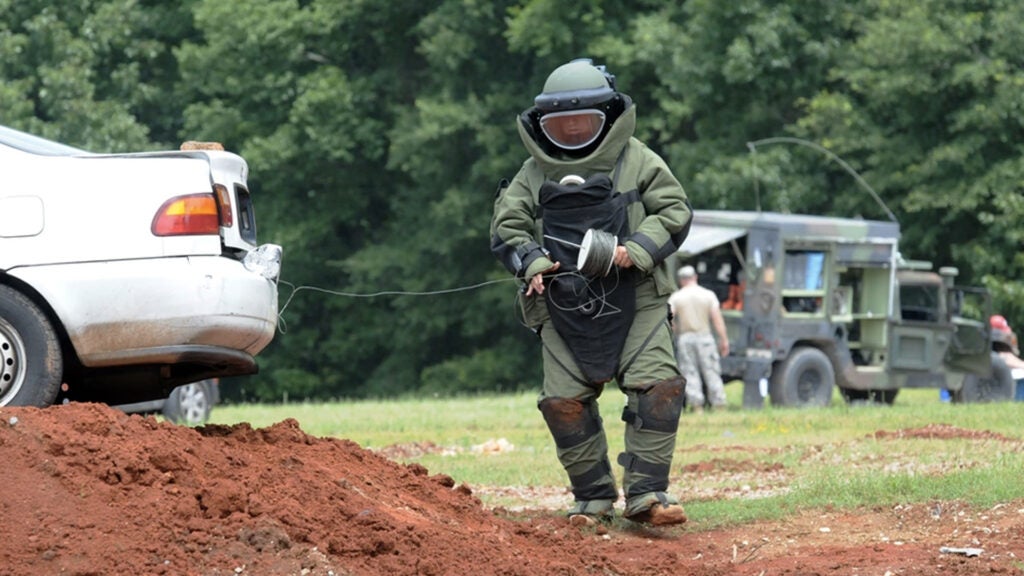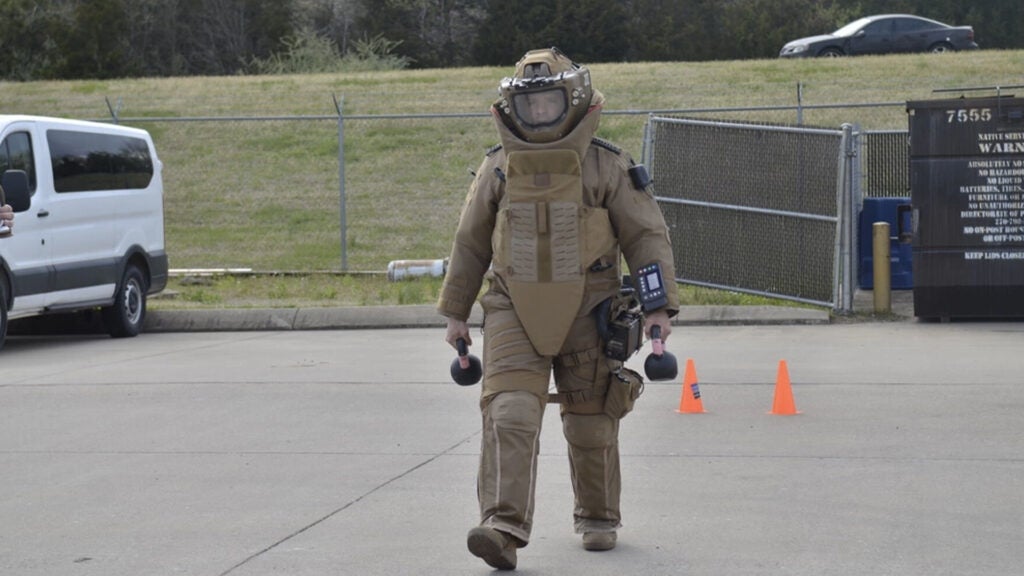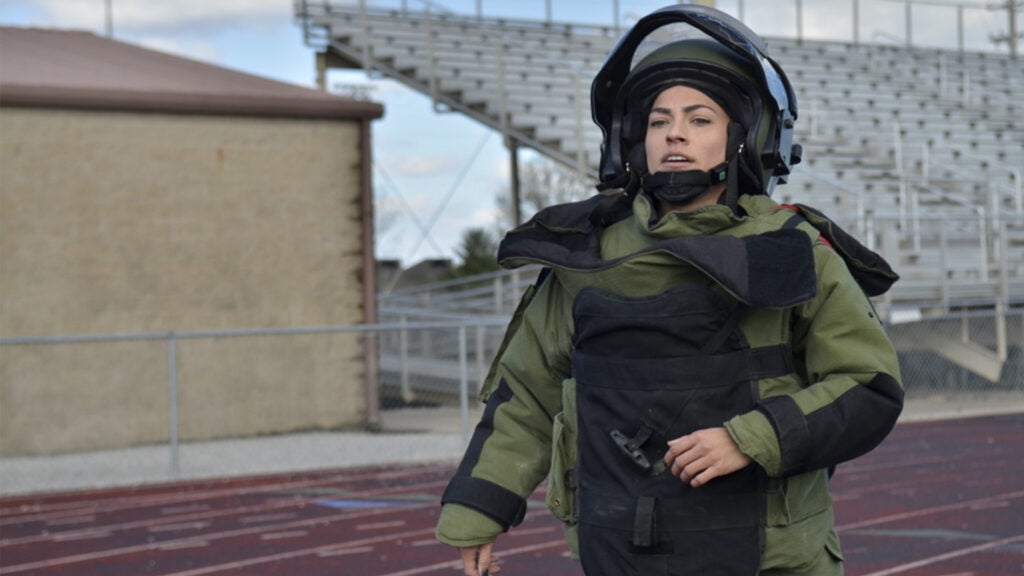Everyone has to get new clothes every once in a while, and the Army’s explosive ordnance disposal (EOD) technicians — the men and women who defuse bombs for a living — may soon be getting a new bomb suit that’s more protective, more flexible and has better sensors than the one they’ve been using for nearly 20 years.
The Next Generation Advanced Bomb Suit is currently being tested by EOD soldiers from the 184th Ordnance Battalion (EOD) at Fort Campbell, Kentucky. The new suits are supposed to have greater range of motion, a better center of gravity and be lighter weight than the old suits, according to an Army news release. The helmet is also supposed to be more stable and comfortable, with better air flow and built-in lighting capabilities.
“The NGABS provides greater comfort and mobility for EOD personnel when mitigating explosive threats,” said Staff Sgt. Gregory Meckel, one of the testing participants. A veteran of Afghanistan and Iraq, Meckel said the new suit was an improvement over the old one, the Advanced Bomb Suit, which the Army has used since 2002.

The ABS was used regularly during the Global War on Terror, and EOD techs came to rely on the suit while defusing countless improvised explosive devices buried alongside roads and in cars throughout Iraq and Afghanistan, where they threatened civilians and coalition troops. The suits are highly specialized, because protecting soldiers against a “blast event” like a bomb going off in your face is not the same as protecting against a bullet, Rob Reynolds, vice president of explosive ordnance disposal at counterterrorism technology company Allen Vanguard, told the Association of the U.S. Army in 2013.
In a blast event, according to Reynolds, there are four threats an EOD soldier faces: the blast overpressure from air rapidly traveling from the explosion; fragments flying from the explosive device and the environment; and the flame and flash from the explosion. The fourth threat is two-fold, involving both the concussion-type injuries that a soldier can sustain from the blast and the possibility of a soldier landing on something unpleasant after being thrown from the blast. It took a lot of research and development to make something that could defend against all those threats, and the military kept improving on the Advanced Bomb Suit over the years.
In 2007, for example, the suit’s helmet was upgraded to include onboard ventilation and power systems, microphones, speakers, LED lights on top of the helmet, and a visor defogger, Reynolds said. Later versions included two helmet-mounted cameras: one for live-streaming video and the other for after-action archiving; and a voice-command system for activating lights, ventilation and other features.
“Operators downrange typically have their hands full,” Reynolds told AUSA. “They are usually carrying a tool called a disrupter under one arm and a tool kit or X-ray system under the other arm. If they are walking into a dark room and need to turn their helmet lights on, they typically have to put all those things down, raise both of their arms and activate the button on their sleeve.”
But with a voice command, soldiers can simply say ‘helmet, lights up’ or ‘helmet, turbo up,’ to get lights or ventilation running while they keep their hands on whatever device they are working on, kind of like Siri but for badasses. The Army bought about 1,400 suits as of 2013, according to AUSA. While the old suits worked, the Army thinks they can be made much better.

“The Army needs a new and dramatically improved bomb suit with reduced weight and bulk to allow the EOD soldier to maneuver more effortlessly in tight or restricted mobility areas while maintaining both balance and dexterity,” according to one pre-solicitation from 2017. The Army also called for a lighter helmet, better protection against small arms fire, better communications, a wider field-of-view, and better low-light or no-light imaging, according to the solicitation.
Now, four years later, the next generation advanced bomb suit seems to have delivered. The new suit includes “increased mobility, 360-degree ballistic protection, weight reductions and a modular sensor suite that provides low light and thermal capability,” according to an Army news release from April.
“The engineers who are designing this suit are actually listening to our feedback and care about what we have to say,” Sgt. 1st Class Eric Thom, of the 184th Ordnance Battalion, said at the time. “During the first round, there were a lot of negatives about the suit that they changed for the better, and I think it just needs a few more tweaks in the design, comfort and mobility.”
Female EOD soldiers also tested out the new suit, which represents a break from decades of military equipment being designed without women in mind.
“The mobility, range of motion and the modular system are huge improvements over the suit we have right now,” said Staff Sgt. Dione Brown, of the 55th Ordnance Company EOD, in April. “The biggest thing is the range of motion – allowing us to do a job quickly with little impediment to our movement means we’ll be able to neutralize our target faster, get in and get out.”
Part of what allows for better mobility is the Modular Scalable Vest, a light vest that allows soldiers to arrange body armor to fit their bodies better than before. The vest helps make the suit “lighter, modular, scalable, mission-tailorable and offers increased mobility and survivability for the soldier,” the Army tweeted in 2020.

We can only hope that the Army also develops a track-and-field version of the new bomb suit. In April, Army Capt. Kaitlyn Hernandez broke the world record for running a mile while wearing an 84-pound bomb suit and 12-pound helmet. Hernandez shattered the old record of 11 minutes, 6 seconds (also set by an Army soldier) when she finished in 10 minutes, 23 seconds.
“[T]he helmet’s definitely the worst part because if you’re leaning forward or backward it’ll take your whole body with you,” Hernandez said. “Overcoming that is more mental. It’s usually a split-second, any time I run and start feeling sorry for myself I just have to get over it and say it’s not that bad.”
Hopefully that record will keep tumbling if the new, more mobile suit comes along. Earlier this year, the Army wrote that it expects to field the new suit in the second quarter of 2023.
More great stories on Task & Purpose
Want to write for Task & Purpose? Learn more here and be sure to check out more great stories on our homepage.
